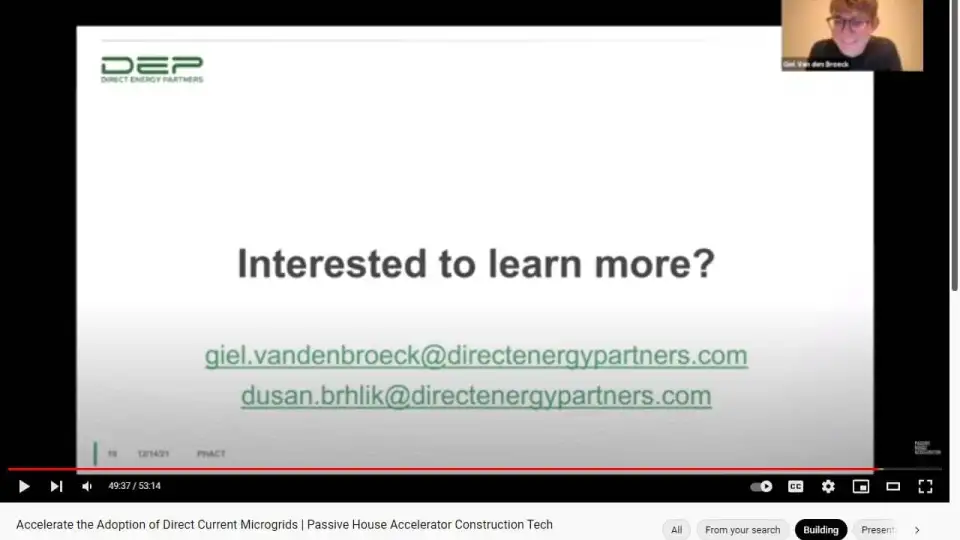Dusan Brhlik and Giel Van den Broeck, co-founders of Direct Energy Partners, joined us on December 14 to talk through the technique, technical, and technology of direct current microgrids. Decentralized microgrids can be a great tool to take your Passive House project to the next level of decarbonization. In the transcript below or the video above, you can learn how Dusan and Giel are accelerating the adoption of microgrids to optimize Passive House performance.
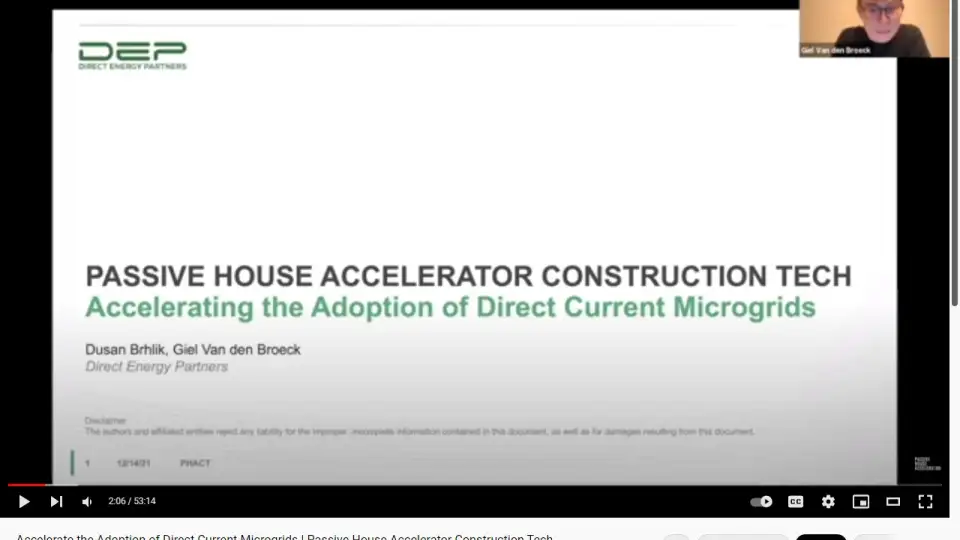
Giel Van den Broeck:
Wonderful. Well, thank you for the nice introduction, Shannon. I hope y'all can hear us properly. So also thank you to the audience for joining us today because actually both Dusan and I are very excited to be here and we will take you on a journey towards direct current microgrids as you already put it correctly. Actually what we will do is we'll zoom into the electrical infrastructure of our communities or buildings, and we'll try to confront you with the kind of less obvious facts. And the fact that we're going to show is actually that the current, alternating current way of distributing electricity is actually no longer compatible with the technologies that we're introducing into our energy system, that we're introducing into our passive houses, like battery storage, like solar PV four generation, but also all these efficient loads in there, heat pumps, air conditioning systems, you name it.
I challenge you during the presentation to find loads in your house that are not supplied by DC or using DC in an intermediate stage, basically. In our presentation, so we'll first have a more kind of why section, so we'll explain you how we're distributing electricity today, how that evolved throughout history and explain why we ended up in the current situation. And then we'll show you actually how things can be done differently, and what are the advantages of having a DC microgrid instead of an AC electrical distribution.
And then the second part of the presentation, Dusan will take you actually to our DC microgrid lab facility, where he's sitting right now and show you in practice, how this technology is actually already proving to be beneficial today. So let's get started with the motivation, the underlying rationale for DC systems as such, why DC microgrids? I'm going to take you back to the future. Let's get back to the early days of electrical power systems in New York, Pearl Street, but all over the world, end of 19th, century, 1880, 1890, we saw a gradual uptake of electrical lighting in streets all over the world.
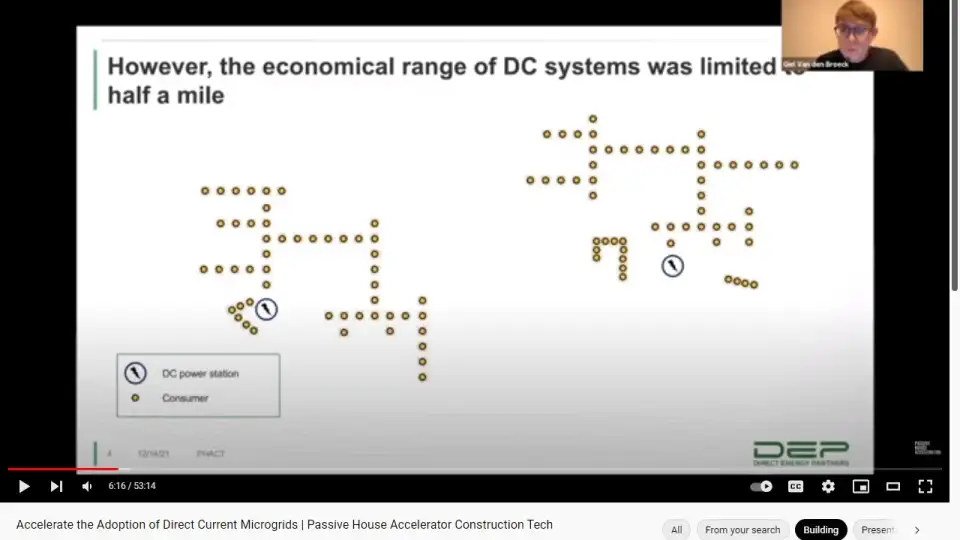
Those were very basic electrical systems. You should imagine like maybe a couple of 100 light bulbs that are connected to a single generator station. And Thomas Addison obviously was one of the pioneers of light bulbs, but he had one major drawback and it actually, there was no electrical infrastructure at all to power them. So at a certain point, he decided on his own to start developing electrical power distribution. He built his own generating station in Pearl Street, New York, and he started distributing power to basically light up all the houses in there. Small scale systems, think about order of magnitudes, 100 kilowatt as such.
And this happened basically all over the world. Also, where I'm living in Belgium, basically same trends appeared, same type of technology was being introduced at everywhere basically. Always small scale systems with a relatively minor amount of consumers connected to it. And these first systems, it may not surprise you, but actually they opted for direct currents to transmit power, direct current meaning actually that the voltage that you measure at a socket outlet is actually just a constant, just continuously one line, one flat line over time.
And that differs from alternating current what you would measure if you would put a probe into the socket today. An alternating current that actually jumps up and down at 60 hertz going positive, going negative all the time. Now, why did we end up with alternating current today? Why is that still the mainstream technology? Well, that's explained by the fact that DC was relatively limited in the range you could cover. You could cover about one mile with a DC distribution line.

That was it. Did that stop DC from being introduced into cities? No, they just resolved it by putting a lot of electrical power stations into our cities, which were dirty causing troubles with air quality as such, which was not a preferred way, but anyway, it was the only way to light up the cities and to power the motors in there. Then we arrived in the 1930s and actually then large investments in infrastructure were made following the economic crisis of 29. And basically government policy ordered a lot of infrastructure upgrades, also bringing power to remote communities all over the US and the world. And there we got stuck there with the range issue basically. And that's where AC came to the foreplay.
Basically AC allowed you to step up the voltage towards higher voltages distributed over miles and miles of distance and locally bring that voltage back down to a level that you can use to power your lighting, your motors. So that's the model that was being introduced 1930s, 1940s, primarily because government supported it, and that led to a massive of electrification all over the world, generating power centrally, distributing it over long distances, bringing it back down to an end use voltage level and then bringing it to end users as such. That's [crosstalk 00:08:37] today.
Dusan Brhlik:
Just to add to it a little bit; back then it wasn't so easy to generate high voltages with DC due to the lack of power electronics, but in order to generate high voltage AC, you just need an iron core and wrap some copper windings around that. And depending on the number of windings you have, you have your voltage, you can transmit power in distances. So it was also very, very cheap to do the voltage transformation, which allowed you to transmit power over distances.
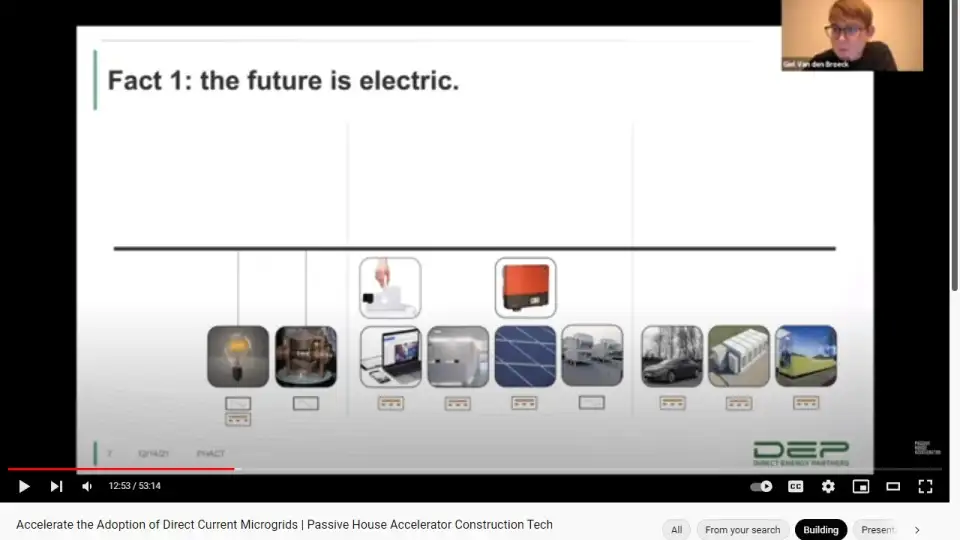
Exactly. So some may say the transformer was the missing technology or the DC transformer. If I don't violate the level of physics there. I do, actually. What's actually the missing piece of technology that Addison like to make DC mainstream. Yeah, that's for sure. Now, times have changed since then obviously. Back then it was used to power lighting. It was used to power some motors in there, but that was basically it. We all are witness of the fact that today the range of applications that require electricity has expanded significantly over the laptops that we're currently looking at and talking to, over our LED lights powering our spaces, but as well on the generation side, electricity is more and more being favored. And I liked actually in the introduction that also electrify everything was mentioned in there, and that's actually what we are doing for sure.
Giel:
Also, for heating ventilation, air conditioning, those systems sitting on rooftops, they are typically electric nowadays. And this trend will further continue with the electrification of transport with more and more battery storage being added to the system, potentially fuel cells. I mean, you can put a lot of slides talking about applications requiring electricity, and that's almost one of the only certain facts in life that our future will be increasingly relying upon that energy carrier basically.
You don't look under the hood of all these applications. Actually the majority of them operates on DC power. So the symbols reflecting the alternating nature of the current and the direct nature of the current. In the early days, lighting didn't really care. You can power a light bulb with DC with AC, it will light up. Motors, it was preferably AC back then, because you had way less maintenance with them. DC motors were more maintenance intensive because you had like small collectors sitting in there that generated parking and wear and tear on the devices. So there AC was actually a preferred technology nowadays, still.
However, if we look into electronics, if we look into LEDs, solar generations, especially all applications where we use semiconductors in between, their DC is actually the nature of the current that these appliances required. Electric vehicles, the same thing, battery storages, the same thing, fuel cells. It's all direct current as such. Heating ventilation, air conditioning is because it has drives that motors in there, again, their AC is the preferred option.
However, that AC differs from the AC that you get at your socket level. So it's not a 60 hertz AC you typically send into an HVAC system, neither to modern industrial drive systems and motors, it's actually an alternating current of a different voltage and frequency that you get out of the socket. That's why for all these applications, we put in power electronics in between. You can call them adapters. you can call them inverters for solar, and actually what all these power electronic converters, as we commonly refer them to, what they all do is converting DC into AC and the other way around.
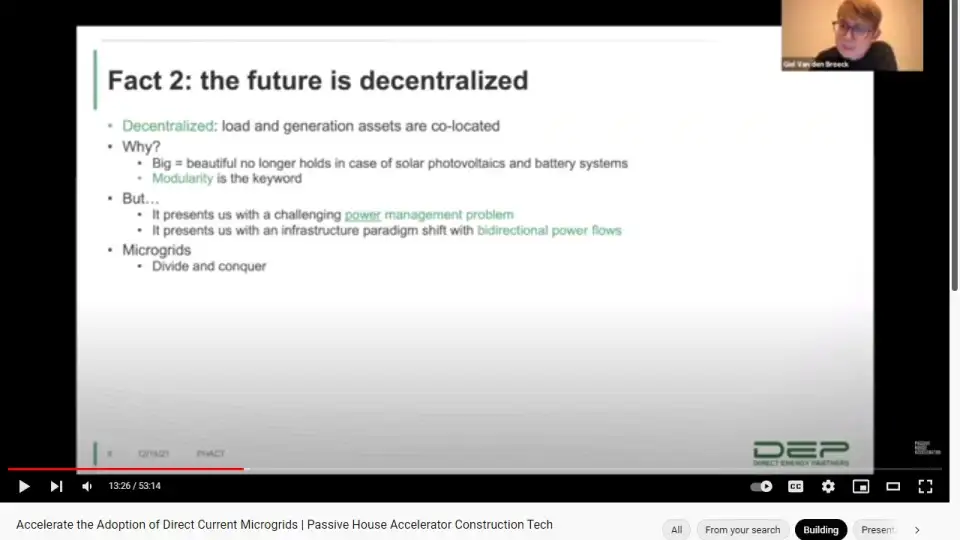
So the future is electric. The future is more and more relying up on power electronics. Now, going back to the first part of the story, our future is also becoming more and more decentralized. So we're also going back to that initial picture of having a lot of decentralized power generators into our systems now being renewable generation in the system. So no longer profiled based small scale generators, but renewable generators, but they are decentralized, and that makes a lot of sense because the solar panel that you put at the utility scale PV plant of multi megawatt systems, that's exactly the same technology as you put into your roof.
So basically economies of scale and efficiency benefits no longer play in this world of renewable power generation. So that's why it makes more sense to co-locate our generators, our PV modules with the loads in there, and try to keep the distance between generation and load short as possible and save a lot on the infrastructure and the energy losses that happen in between. The system is also becoming more modular. So we're using PV modules, we're using power electronic modules. So that's making it also more reliable in a way that no longer there's like a single large scale central power station that presents us with a single point of failure.
However, managing all these energy flows onto our system, that will present a significant challenge ahead of us where it's not just a handful of generators that need to be synchronized and controlled. It will be millions of them basically. And that's where microgrids come in the story. So we're talking about DC, but we're talking also about DC microgrids and we at Direct Energy partners, we are strong believers of microgrids because they allow kind of divide and conquer approach. So imagine having all those millions of generators loads all exchanging energy one with another, how are you going to manage this entire system?
Well, by subdividing that large part of generators and loads into smaller scale microgrids. You can actually manage all, all these power flows in a more proper manage. What is a microgrid? It's basically a set of generators, loads, and storage systems that form a system altogether, and they can exchange power with neighboring microgrids, but they also achieve a certain level of independence. They can stand alone if that would be a economically the best option to do, or just technically necessary. For instance, if there are lot like power disruptions flowing natural disasters or utilities just causing preventive blackouts in there. Dusan, feel free to jump in...
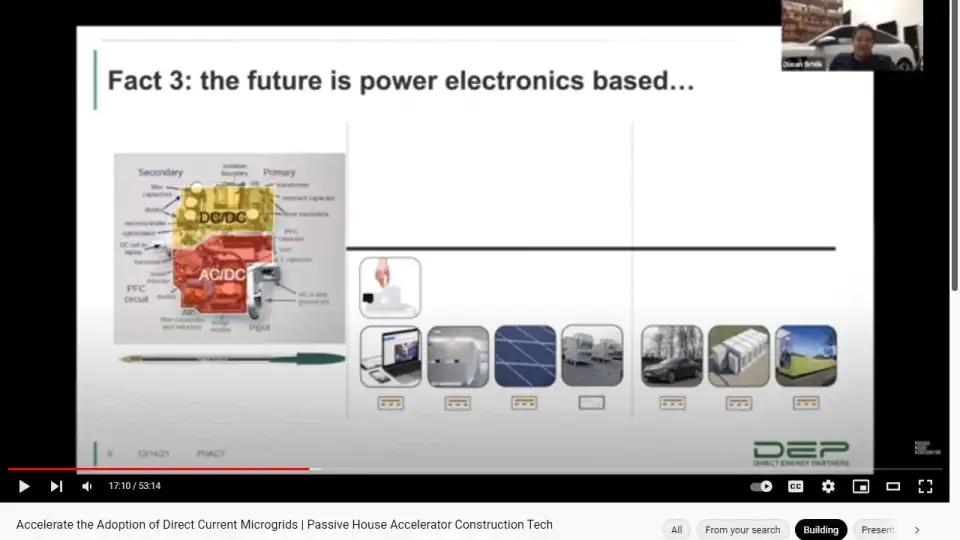
Dusan:
I'm excited to get to the real world scenarios and talk about the projects and how we really accelerate the adoption of these systems, but this is good. The power electronic-based future. I particularly like this slide, and you will talk about it in detail because it will show you really how much you're really wasting between just in capital equipment, just converting AC to DC. I think it's typically not apparent to people, so I'll let you take it from here.
Giel:
Yeah, exactly. We're often confronted with questions like, okay, but if we're going to convert to DC, isn't that like having a little lot of repercussions on these adapters that we're already using today? And actually if you open the things up and we frequently do that as hands on power electronic engineers, you typically recognize a very dedicated parts towards rectification converting AC into DC, and apart then converting that DC into a lower or higher DC voltage depending on the application. Your laptop adapter typically looks like this.
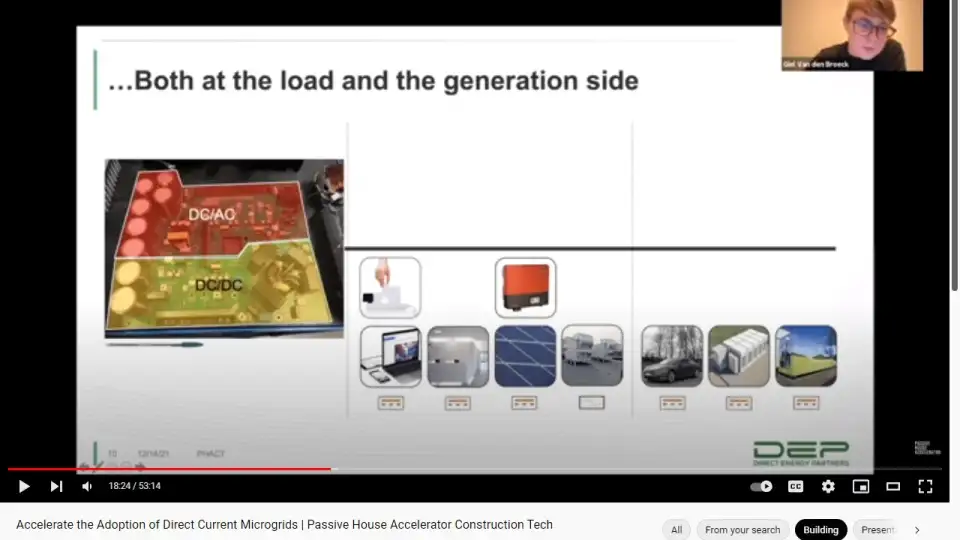
So there's this red part for rectification and this yellow part for a voltage control in there. The same applies for solar inverters. Then we're looking at, of course at a larger unit as such, but again, we have a DC/DC stage taking in the solar power and then a DC/AC stage to invert that and make it compatible with the voltage that are utility provides today.

So DC results in a lot of simplification because actually our current system looks like this. If you break it down into blocks, although this may be like single units hanging in your garage or sitting somewhere, internally, they consists of two major parts. And it's pretty obvious that by actually moving towards a DC infrastructure, where we move that AC stage as much as possible front, we can save on material in between. We can save on electronics in between and those savings...
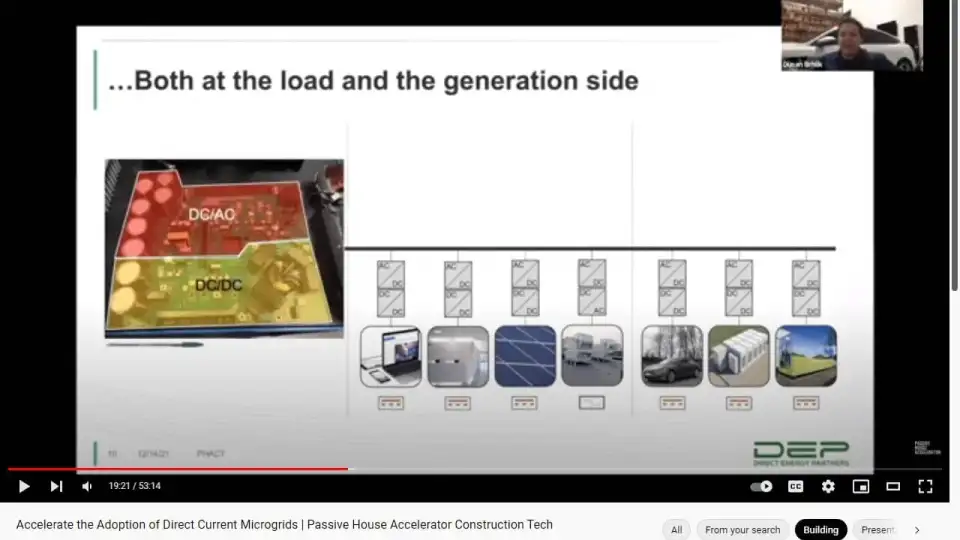
Dusan:
Let's make this a little more interactive. So can you go back to the previous slide? Sitting here in the lab, I'll do a little plug for Lumen patch too, as I see Derek joined. So this is a lighting driver that's been taken out of a 2x4 fixture, and you can see the amount of electronics that are involved and mainly they are there for converting AC to DC, doing some filtering and whatnot, just to power LEDs, which are natively DC. And this thing right here, which is a Lumen patch DC/DC driver, is the equivalent and DC/DC to run the exact same light on DC.
I mean, if this doesn't convince you that DC is more efficient, I don't know what does, but we have many more examples like these. And so we can even improve the electronic ways that we generate by moving everything to DC and minimize that. All right, just thought that was neat.
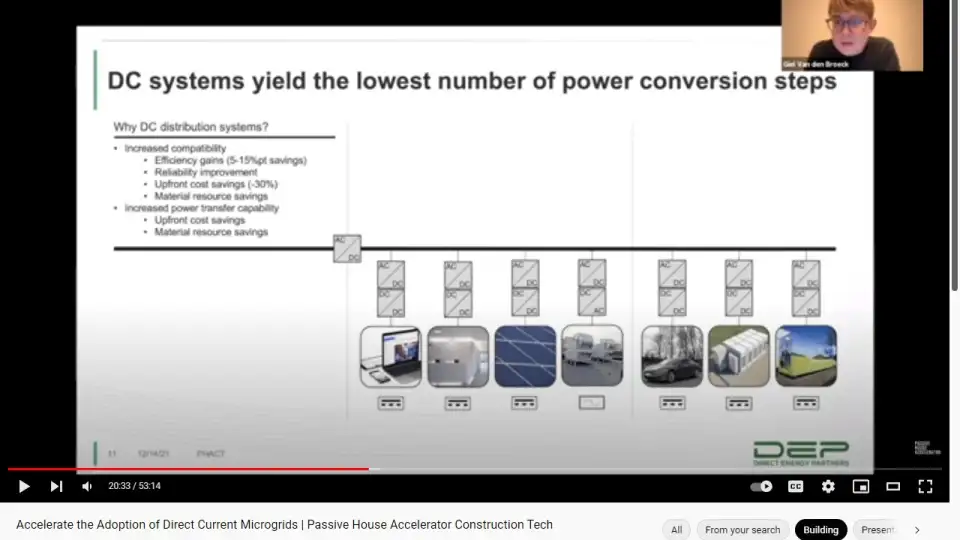
Giel:
Yeah, exactly. So minimizing electronic waste, but also lowering costs. You have less parts in there, so it costs less upfront, but also if there are less parts where the current needs to go through, you have less in that entire chain. So the better compatibility between DC infrastructure and the devices that are connected to it yields a lot of benefits in terms of efficiency, in terms of material resource savings, but also reliability improvement, less components that may fail in between.
Besides savings on these power converters, which is typically the main driver for DC microgrids, the same cable infrastructure can be used to transfer power as compared to AC. Side note, it depends on the voltage and stuff, so we need to do some math to prove that, but typically for a similar order of magnitude in voltage as with AC, we can transfer about 40% more power across the same wiring infrastructure, and that perfectly fits with our increased level of electrification.
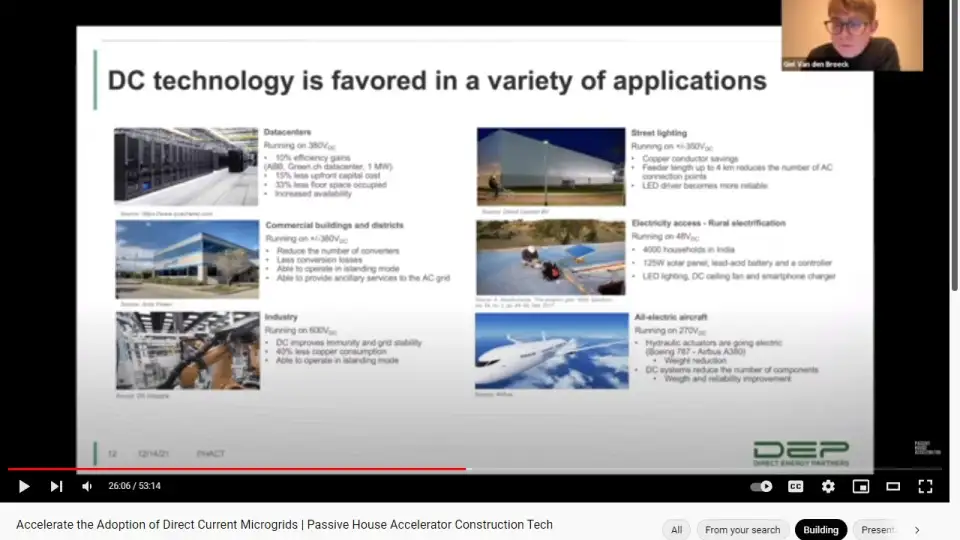
I wonder, is this already applied somewhere? Are there real applications out there in the field using it? And for sure they are, this is sitting in our lab currently where we're working on it, but actually this DC trends or got its like renaissance about 15 years ago. And that started off with the data center in industry. So the large digital players in the world building data centers, multi megawatt facilities. Five years ago, I was talking these for a like five megawatt facilities today. These are 40 megawatt facilities. They consume for about every square feet, approximately the same as typical household would do.
And you have like a lot of server infrastructure there, IT electronics, so it's quite obvious that by distributing DC power in there, instead of AC, you save a lot of electronics in these systems, you reduce the footprint. There are examples out there proving that you can save about one third of the overall floor space in there, but also you generate less heat. Those megawatts of electrical power go in there, basically get out there as heat. It needs to be cooled. So there is also in a second stage savings in the cooling system overall. So these were the first adopters of DC we can say.
Secondly, there are commercial buildings and districts where you typically find combinations of solar storage, EV charging infrastructure in there. Again, say motivation, efficiency, benefits, and converter savings. It continues in industry, so within industrial manufacturing plants, and especially here in Europe, there are a couple of pilot projects ongoing right now where part of the industrial production lines get powered on DC. Why do they opt through DC technology in their? It's because actually they are willing to improve the uptime of their manufacturing lines. That means that they are starting to introduce battery storage in the production lines, where you find battery storage, where you find like motor drives for all these server machines driving the robot takes, driving the conveyor belts, and you save again on material in the system. So it's basically the trend towards an increased uptime, improved power quality that's pushing the industrial manufacturers towards DC technology.
For street lighting. there are a variety pilot projects out there. Of course, the LED driver, as it already perfectly demonstrated by the fact that you can reduce the size almost by a factor of ten as Dusan already showed you. Within street lighting, there's another additional benefit, and that's basically you can connect more lights and you can cover longer distances as compared to AC. And that's because now we can increase DC voltages because we have these power electronics now. So the DC transformer, as we are already talked about now is basically a need that has been fulfilled by power electronics that were introduced late 1960s.
Also an application that's close to our heart is remote, rural electrification, because there's still now the number drop, but we are still near one billion people worldwide not having access to electricity because there's no electrical infrastructure being deployed. And there you see solar home systems popping up, small kits that these people can purchase for a couple hundred of dollars and they get electrical power. And it's obvious these things just operate at DC because it's evident to choose for it. Why go through the hassle of building it in AC?
And then there are non-fixed applications, mobile applications, onboard aircraft, onboard chips in their... In aircraft for instance, one of the major drivers towards DC is actually weight reduction. So a lot of the hydraulics in there are being replaced by electrical actuators, operating flaps to fly the aircraft. And those as well require converters in there. And those converters can be small. You save on weight as such. So the advantages, benefits are actually very obvious, but we unfrequently recognize them because we're so much used to AC as such today.
DC microgrids worldwide. We map them. We keep track of the pilot projects that are out there worldwide. So we have about 80 currently on the map, if your area or you know there's something in your area ongoing that's not yet on the map, feel free to reach out to as I will make sure that a pin gets dropped, but I also invite you all to make sure that actually your area gets covered in there as well. So a couple of years, we definitely hope that actually we can no longer keep track of these number of DC microgrids worldwide, because that would actually mean that the technology has eventually made it to a mainstream technology for power distribution, but for now we still keep track so send us yours and we'll edit in there. It's freely available on public on the internet so go and take a look for sure. And with that being set, I'll hand it over to Dusan and we'll gradually get to our lab tour in there.

Dusan:
Okay. Sounds good. Thanks for that great overview. So Giel brought us to the 21st century and showcased to everybody why DC makes sense today. So hopefully we're on all on the same page. With this slide I'd like to showcase some of the real world projects that we are working on to bring a flagship DC microgrid projects to the market. When we started this business Giel and I, we thought we were starting a business, but it turns out we're starting a market too.
We still live in an AC world, but we live in a DC world with an AC infrastructure. And there are still a few challenge is when you deploy these DC micro grids, but nothing that we can't overcome. So from the top left corner, I think this is one of the most ambitious and exciting projects we have going on in Hawaii that's in design currently. This is called the ridges at the Olomana Heights, and it's a community of luxury homes. And this entire community is being self-sustained from a direct current microgrid. So the generation is solar as DC and energy storage. And we have some hydrogen fuel cells there as well. And we have a central power plant that's distributing power to each home as DC.
And then locally, we also consume as much power as DC as possible. And for some of the legacy loads that still require AC power, we just locally generate AC. There are a lot of challenges in designing something like this, so we're always looking for partners and companies that can help us overcome those challenges. But I'd say primarily it's mainly about how do you actually it distribute power within the home as DC, right? We know how to distribute the power within the community, but once you get inside the home, things can get a little bit tricky.
And so in this particular design, because everybody is on the same DC microgrid infrastructure, this community is not only self sufficient, but it's also resilient. Homes can actually share power with each other, if they need it to help them weather any kind of adverse weather conditions. The picture in the middle, this is the project that we worked on with David Peabody up in Maryland. And we were involved in the design phase of this project. And up in Maryland, they are also employing six homes and connecting them with a DC microgrid. I don't think this particular community goes as far as power within the home as DC, but the distribution network behind the meter is definitely DC.
That one had its own challenges because it was in a regulated utility and in a regulated utility, you can't share power across property line, so it's more of a regulatory issue rather than a technical issue. We have a couple more projects I'm just going to highlight here. We are designing an apartment complex in Hawaii as well. So the picture on the bottom middle that's a 34 unit apartment complex, and it's pure DC. We have a parking garage that's wrapped in building integrated solar, and we generate enough power to meet the loads of the building and to charge batteries.
So really there is a single point of connection to the utility, but the utility is used as a backup. And I think that's true with every DC system that we design. We still put one connection to the utility there, but it's only used as a backup for these particular projects. And so here we generate power as DC, we distribute it as DC and we consume it as DC. So this building has its own power plant in a basement, if you will, and then all the power gets distributed between the floors as DC and goes to departments as DC.
There are still some like with that one, there's still some legacy codes in our national electric code that prevent us to build a pure DC building if you will. For example, the National Electric Code requires you to have AC sockets every six feet or so. I'm not sure why a standard picks and a technology as an AC socket, but I think over time, that's going to change. So for now, we still have to put in some AC socket just because it's required. We're not going to die on that hill, but we do see that it's going to change over time. And then Giel has a couple projects in Belgium. So do you want to talk about that one?
Giel:
Yeah, just briefly. One of the main projects in Belgium that we're having here is in the lower right corner. That's an industrial site Greenfield, basically. It's currently being developed and actually we're going to build DC infrastructure to basically distribute power and primarily share power between office buildings on there. So there are about 20 buildings planned there, and we're currently realizing the first blueprint of one of the office buildings that will then be replicated across the entire site.
And what's unique to this project is the level of electrification and the level of autonomy that this site will have as compared to similar sites out there that typically source their power externally. So here really the goal is to share power and to generate nearly 100% of the energy on site. And then on the upper right corner, that's actually more kind of luxury project that we're doing that's basically a new IT company or an IT company, an existing one that's building a new office building with also some living areas in there. And there, the goal of the developer is really to introduce a lot of innovative technologies.
So he took us by the hand to basically design the electrical infrastructure for DEPs And basically for us, that's an opportunity to also showcase and test basically some real new DC applications that haven't been used into the other projects before we put them into practice. Now, one more thing I want to highlight is actually about the autonomy, about the capability of these DC systems to operate in islanding mode and work standalone. I don't know how many of you have gone through the hassle of making an AC microgrid capable of transferring from grid connect to islanding mode.
Although in theory, it's perfectly possible to go from grid connected to islanding mode with transfer switches. It requires a lot of hardware switching in between. It never gets done simultaneously. There's always a very brief though, on millisecond interruption, you will notice it into the voltage in DC transferring from grid connected to islanding mode is straightforward, easy to accomplish. You don't need additional hardware to accomplish it because you already have inverter sitting in there anyway. So it's merely a set point. That's basic it. I'll go hand it over back to you, Dusan.
Dusan:
All right. I think this is a good... I don't know how much time we have Shannon, but I'd like to talk about the lab a little bit.
Shannon:
You've got some time, Dusan. Go ahead.
Dusan:
All right. Sounds good. So I think it's a pretty good segue to kind of showcase what we're working on here. A lot of these projects that we are are designing also require a lot of R&D on our part to either convince manufacturers to provide some of the products to these projects or for us to develop new control systems and strategies or products that are just not available yet. So I'm just kind of going to do this live. I don't know how's going to work, but let's go with it. So we are in our DC microgrid lab here; we have 34 kilowatts of solar on the roof; and everything in this lab pretty much runs on DC. So these high bay lights behind me, they run on high voltage DC. These big ass fans they run on DC. They're all directly connected to solar. We have a electric car, and I'll talk about it a little bit, that's connected to the same DC network, appliances from LG, washers, dryers, and TVs that are connected to the same DC distribution network. You might ask, well, how do you distribute this throughout the building? Well, we have to design what's called a power distribution pattern.

Giel was talking about islanding, and yes, it's possible to island AC microgrids with equipment transfer switches and isolation equipment, but this single power distribution panel that's the exact same size as your typical lighting panel that you have inside a commercial building, these are your circuit breakers. This also takes solar directly in, it takes batteries and power from a bidirectional converter. So when you're actually switching your loads on and off inside the building, your lights and fans, or EV chargers, they're no longer powered from a single source of energy. They're powered from three sources of energy. And if one goes, then the other one fills in the devoted energy, but because everything is on the same power type DC, this is the only equipment you need. If you ever try to buy a Tesla Powerwall, for example, they sell you the Powerwall, but in order to make it island, you need to buy yeah, 25 or 30% more equipment, which will take up space on your wall as well. But with DC, everything kind of integrates really nicely. So that's kind of what some of the equipment looks like that we have to develop because the market doesn't have it.
If it was the daytime, you would see that we are charging now a... This is an Audi e-tron. Last week we had a Tesla here too, but we're working on the charging controls to charge these directly from solar. So solar doesn't go through an actual converter. It comes here directly to charger and then from the charger goes directly to the car. And so there's just something about converting those photons and taking that energy directly into your car. And this is what I told Shannon that not even Elon Musk is doing this today, but that's because we still live in an AC world and we don't have a DC distribution network that you can plug these DC chargers into.
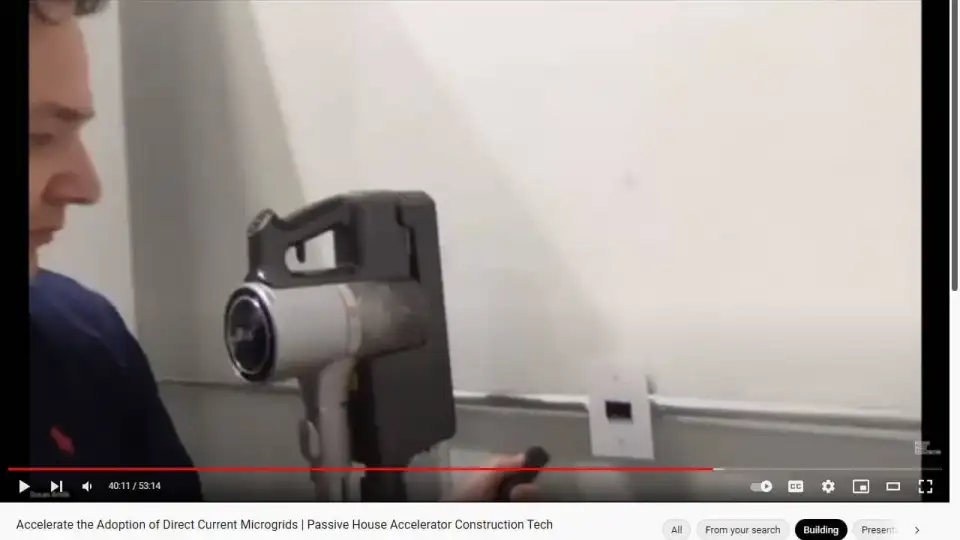
I guess, let me show one more notable thing here in the lab. These are what's called high voltage DC plugs or DC sockets. And they can carry a lot of energy up to five kilowatts or so. And so at home, you have your 240 AC sockets that look different than your 120 AC. Well, this is what a DC socket looks like. It's a company called Anderson Power that makes a socket, but the plates and everything, we kind of have to productize and make it our own and put it into these projects because no sells these yet. And so with DC, people ask, well, what do you do about arc flashes because DC doesn't extinguish its arc on its own.
Well, these little connectors are kind of designed in a way that they extinguish the arc before they even reaches the end user. So I'd say those are like the most notable things here that we are working on. And so we're working on DC safety and DC control systems and I'm not sure what the next presentation slide was going to be. But as you can understand, it's very cumbersome or difficult to deploy these systems today. We realized very early on in forming our company that we don't stand any chance of accelerating the adoption of the DC systems if we don't do anything about the high cost of engineering and the high cost of barrier to entry of adopting these DC systems.
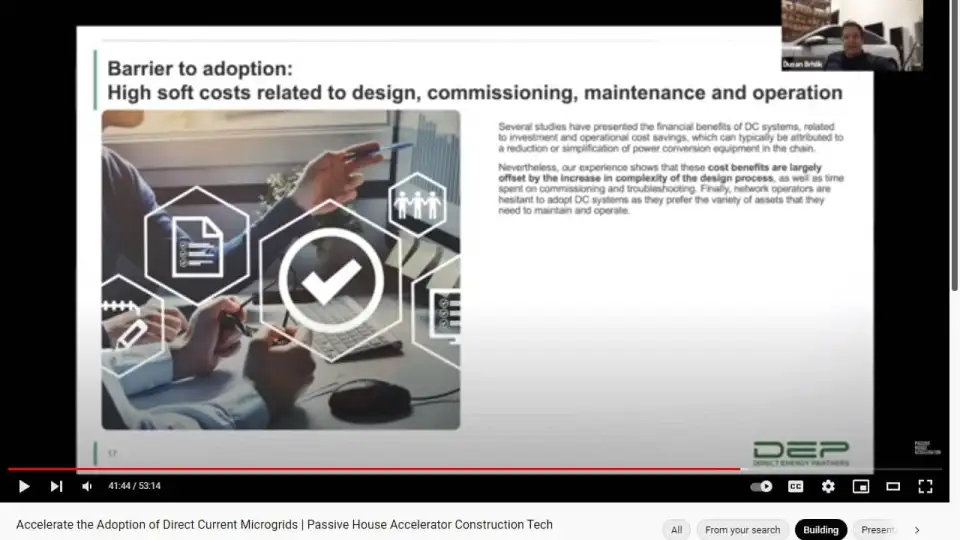
What Giel and I have been working on for the last 18 months or so is we've designed a software tool, which allows us to deploy these DC systems much quicker and much easier. It kind of takes all the engineering around making sure that components work together. So interoperability, making sure that systems are stable, making sure that systems are safe. It kind of takes it into the background and literally reduces the time to design these systems by more than a factor of 10, if you will. So that's kind of our effort of trying to figure out, well, how do we actually make sure that more people can get access to these systems? And so we want to make sure that the design and engineering is easy, as well as the deployment of controls and commissioning of these systems as well. Giel, do you want to add something to it?
Yes, exactly. I mean, we started developing this in house because we really had an emerging need. I mean, we needed to become more productive because more and more projects were coming our way and we're of course, very happy that we're involved in a lot of these initiatives and that people reach out to us. That's definitely a sign that DC is taking off, but at the same time, it confronts us with our own constraints and limitations. So just like architecting these systems actually by having now just a very simple tool to draw everything we could already like safe indeed about, yeah, I'd say that you can now draw your system in, let's say 10 minutes instead of like two, three hours that you would typically require.
But besides actually, I mean, while we started working on this, and first that start with the initial idea, actually we came across a lot of additional use case as well. For instance, also to like centralize all the information because typically when we start working on a DC system in the early days, actually we maintain a lot of information in separate spreadsheets. We maintain some information in shared folders, data sheets, manual rules, et cetera. And actually by the time when you went towards commissioning, actually a lot of information that you needed to get your system up and running was like distributed somewhere sitting on any shared drive and mailboxes. And that's also kind of a thing that we started working on. Also try to get all that information in a single place where that once you're in the field, you can just go there with your iPad, you can consult product manuals, you can consult product specifications.
And having that information in there also helps you to identify issues already in the design stage, will that LED lighting driver work if my voltage drops to 320 volts starting from 380, will actually the wire size be appropriate for what I needed here? Because that's also then an extension we started to build. We can simulate these systems. We can look at what the voltage would be in case this is the loading condition, we can look at what happens if there's a short circuit on our DC system, how quickly will the voltage drop if we put in the right protective devices that we put in a lot of [inaudible 00:45:30]. A lot of questions that you as a design engineer are confronted with are actually tackled by means of the software tool. And that completely fits into our mission actually to accelerate the adoption of DC technology. And actually in our next step as a company is actually to release this tool chain to the outside world.
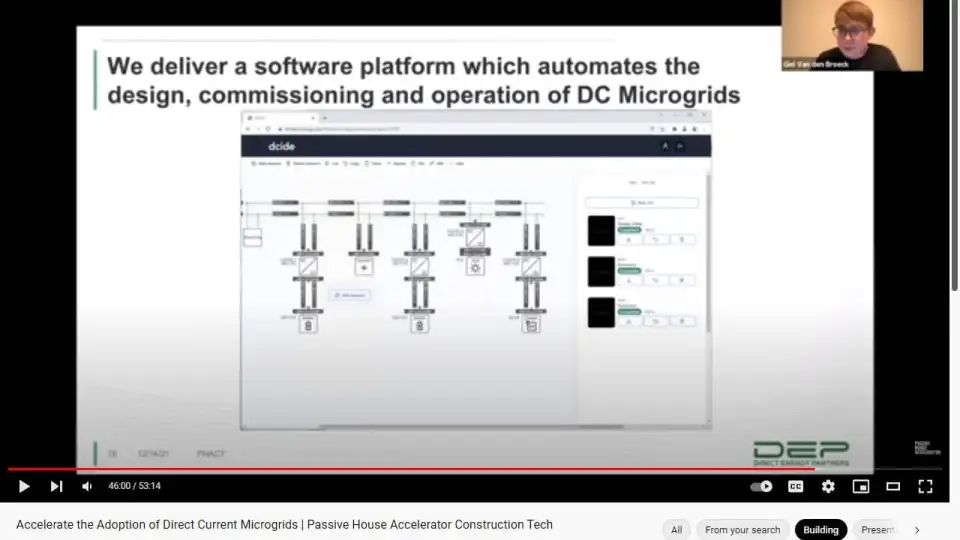
We're currently in the process of onboarding partners. We already have a couple of them that started using a tool that was first developed for internal use. And that way we're trying to actually equip existing installation company system integrators with the expertise to design those DC systems without having to go through an entire study. We really guide them through the process and provide them all the way to kind of recipe of how to design and operate DC systems.
Dusan:
Yeah. And so I I'd say, this tool is really good for assessing safety, stability, reliability, interoperability of components, and helps even develop the controls for these microgrids. We also found that to be something that's very expensive and it's lacking in the market as well. So yeah, there's some technical challenges and hurdles in implementing these microgrids, but I'd say most of the hurdles are around operation and maintenance of these larger systems. Technically I think you can, how do we accelerate the design process and deployment process of the microgrid, but there's also the business end of things around operation and maintenance. And so we're always looking for partners can help us realize these ambitious visions.
Shannon:
I think that's a great place to hold for just a moment and ask you guys besides sharing all of your thoughts, all of the best practices, the costs, the design, and open sourcing it, where did you get your inspiration? I think I mentioned, we might ask you about this. Do you have anyone who inspired you to get together and start this company and start driving this adoption forward?
Dusan:
Well, from my end, I actually started with this DC microgrid about back in 2012, I think. I was part of Bosch's management trainee program. And when I graduated from that program kind of wanted to start my company and then Bosch, one of my old mentors, John Sessel, he asked me, he's like, "Hey, would you like to join a startup within a large company?" And so the startup was actually to create DC microgrids. And I think that was the best thing I've ever done. So Bosch funded an internal startup for DC microgrids. And during that time, I think it lasted for about five years or so. And during that time we deployed microgrids across the nation and even changed the national electrical codes.
But at some point Bosch kind of lost their patience and they got out of the business. And that's when I had decision to make, which was kind of a hard one, whether I take this really nice six figure offer, and move to Germany, do another startup, or do I start my own business and kind of fulfill the mission that we started? And so, well, here I am today, and so I think yeah, 10 years into it and going strong.
Shannon:
Thank you, Dusan. And Giel, what about you? We've got a couple minutes before I have to hand it off to Zack. You don't look like you have that long of a track record because you look very, very fresh out of school to me.
Giel:
Well, actually the story of Dusan and I, I mean, we definitely see some parallels in there. In my case, it started about in 2012. Back then I was at university finalizing an engineering degree. And I happened to dive in one of the subjects in the list, and that was about getting to DC microgrids was my promoter back then, who was also very much involved with Berkeley National Lab, et cetera, that pushed me actually towards this subject. And to me, that was more like a way to before I graduate, let's just review how electrical power is distributed completely.
By diving into DC, I actually have an opportunity to kind of go back to the basics and find out how electrical power distribution actually worked and review all the technology. And afterwards, I ended up doing a PhD degree with the same promoter in there. So I spent about four years at the university there. And actually I'm very grateful that he gave me that opportunity because I was allowed to build the first DC microgrid of the 21st century in Belgium by the research funds that were provided back then, and that opened like a lot of doors then-
Shannon:
I can imagine. Yes, that is quite a first.
Giel:
Exactly. And then at the end, I arrived at these typical existential questions, like okay, you're near your PhD degree. Okay, what's happening next? Will you go for postdoc whatever. And then I was just sitting together with my father in the southern part of France, and I was already playing with the idea for a couple of years to start an own company. There wasn't an interest from industry. And I just then went ahead and one night I just said, okay, let's do this, let's try this out. We have nothing to lose and feels like the only way to kind of contribute towards accelerating the adoption worldwide.
I ended up doing that, and then a couple of months later Dusan and I partnered up and said like, look, this is not going to work if we just tackle this on our own. We need to share insights. I mean, our vision of accelerating this and making this also a more open approach as compared to what it has been before, it's very much aligned and yeah, since then we're like partners in crime, I guess.
Shannon:
Partners in acceleration is more like it, and I'm very glad the two of you met.
